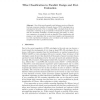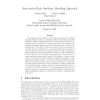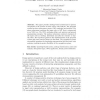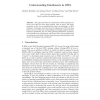99
Voted
SEMWEB
2010
Springer
14 years 11 months ago
2010
Springer
Analysing the performance of OWL reasoners on expressive OWL ontologies is an ongoing challenge. In this paper, we present a new approach to performance analysis based on justifica...
111
Voted
DLOG
2010
14 years 11 months ago
2010
Abstract. One of the most frequently used inference services of description logic reasoners classifies all named classes of OWL ontologies into a subsumption hierarchy. Due to emer...
109
Voted
ACL
2010
14 years 11 months ago
2010
We describe the strategy currently pursued for verbalising OWL ontologies by sentences in Controlled Natural Language (i.e., combining generic rules for realising logical patterns...
129
click to vote
IJSWIS
2007
15 years 28 days ago
2007
This paper presents a hybrid, extensional and asymmetric matching approach designed to find out semantic relations (equivalence and subsumption) between entities issued from two ...
115
click to vote
KES
2008
Springer
15 years 1 months ago
2008
Springer
This paper presents ontology-based architecture for pattern recognition in the context of static source code analysis. The proposed system has three subsystems: parser, OWL ontolog...
109
click to vote
DKE
2010
15 years 1 months ago
2010
UML class-based models and OWL ontologies constitute modeling approaches with different strength and weaknesses that make them appropriate for specifying different aspects of soft...
146
Voted
ECAI
2010
Springer
15 years 2 months ago
2010
Springer
Abstract. One of the most frequently used inference services of description logic reasoners classifies all named classes of OWL ontologies into a subsumption hierarchy. Due to emer...
149
click to vote
OWLED
2007
15 years 2 months ago
2007
There are many query languages (QLs) that can be used to query RDF and OWL ontologies but neither type is satisfactory for querying OWL-DL ontologies. RDF-based QLs (RDQL, SeRQL, S...
106
click to vote
OWLED
2008
15 years 2 months ago
2008
This paper describes the explanation in OWL landscape. In recent years there has been huge progress, both in theory and implementation, in the area of explaining the causes of enta...
OWLED
2008
15 years 2 months ago
2008
OWL ontologies are complex computational artifacts that are intimately connected with conceptual information and with application issues that are not easily explicable in the conte...





